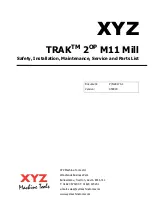
G.SHDSL.bis Router User Manual V0.01
38
4
4
.
.
2
2
.
.
1
1
.
.
3
3
T
T
C
C
P
P
A
A
M
M
T
T
y
y
p
p
e
e
TCPAM stands for Trellis Coded Pulse Amplitude Modulation. It is the modulation format that is
used in both HDSL2 and SHDSL, and provides robust performance over a variety of loop
conditions. SHDSL.bis supports 16 level TCPAM line code(TPCAM-16) or 32 level TCPAM line
code(TCPAM-32) to provide a rate/reach adaptive capability, offering enhanced performance
(increased rate or reach) and improved spectral compatibility.
The default option is Auto. You may
assign the different type manually by clicking the caption TPCAM-16 or TPCAM-32. Only Annex
AF and BG can apply TCPAM-32.
4
4
.
.
2
2
.
.
1
1
.
.
4
4
D
D
a
a
t
t
a
a
R
R
a
a
t
t
e
e
For 2-wire model
(n*64kbps)
Y
ou can setup the SHDSL.bis data rate in the multiple of 64kbps.
The default data rate is 5696Kbps (n=89).
For using Annex AF or BG
TCPAM32 ; data rate is 192Kbps ~ 5696Kbps (Nx64kbps, N=3~89)
TCPAM16 ; data rate is 192Kbps ~ 3840Kbps (Nx64kbps, N=3~60)
For 4-wire model
(n*128kbps)
Y
ou can setup the SHDSL.bis data rate in the multiple of 128kbps.
The default data rate is 11392Kbps (n=89).
For using Annex AF or BG
TCPAM32 ; data rate is 384Kbps ~ 11392Kbps (Nx128kbps, N=3~ 89)
TCPAM16 ; data rate is 384Kbps ~ 7680Kbps (Nx128kbps, N=3~60)
2-wire model
4-wire model
Annex AF/BG
TCPAM-16 192~3840 kpbs
384~7680 kbps
TCPAM-32 192~5696 kpbs
384~11392 kbps
4
4
.
.
2
2
.
.
1
1
.
.
5
5
S
S
N
N
R
R
M
M
a
a
r
r
g
g
i
i
n
n
This is an index for line connection quality. You can see the actual SNR margin in STATUS
SHDSL.bis. The larger the SNR margin, the better the line connection quality.
The range of SNR Margin is -10 to 21.
If you set SNR margin in the field as 3, the SHDSL.bis connection will drop and reconnect when
the SNR margin is lower than 3. The device will reduce the line rate and reconnect for better line
connection quality.
4
4
.
.
2
2
.
.
1
1
.
.
6
6
T
T
C
C
L
L
a
a
y
y
e
e
r
r
There are two TC layer setting on this router: EFM layer and ATM layer. It is based on the
networks connected: ATM-based Access Network or Ethernet-based Access Network.
















































